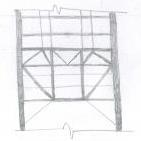Leaderboard
Popular Content
Showing content with the highest reputation on 09/05/19 in all areas
-

Base Shear Calculation
UmarMakhzumi and one other reacted to Badar (BAZ) for a topic
Mat cannot be part of inertial forces. The slabs with in basements can participate depending upon the level of grade on both sides of building, the stiffness of basement walls or other below-grade vertical members and type of soil. You can take a look at this document: asce-003_asce_7-10_commentar.pdf https://cdn.ymaws.com/www.nibs.org/resource/resmgr/bssc/asce-003_asce_7-10_commentar.pdf2 points -

Comments/Observations regarding modelling in ETABS
tanvirce12 and one other reacted to Badar (BAZ) for a topic
*Comments/Observations regarding modelling in ETABS* *Doc No: 10-00-CD-0006* *Date: May 06, 2017* Some of the observations made during extraction of results from ETABS (v 9.7.4), for design of reinforced concrete members, are being share in this article., 1) Minimum Eccentricity ETABS always considers the minimum eccentricity for selecting the design moment of columns irrespective of the probable behavior of the column, whether short or long column. See section 10.10.6.5 and its commentary of ACI 318-08 which deals with minimum eccentricity of long columns. You should always check the design moments that ETABS uses for columns if you want to bring down the cost of construction. 2) Unbraced/ Braced Preference If your model has lateral loads, ETABS will give you design moments in column irrespective of its status as braced or un-braced as per ACI 318 criteria. You should investigate if the storey under consideration is braced, or un-braced (10.10.5.2), and decide appropriate design moments of columns. 3) Time Period ETABS has a tendency to select a time period of the building that is considerably less than the value obtained by the approximate method, Method A, of the section 1630.2.2 of UBC 97. To quote the FEMA 451 document: ''Because this formula is based on lower bound regression analysis of measured building response in California, it will generally result in periods that are lower (hence, more conservative for use in predicting base shear) than those computed from a more rigorous mathematical model". So, there is no need to use the value of time period that is lot less than Ta. One should always check the time period used by the software; ETABS can overestimate the seismic force by more than 2 times. Method A gives lower T and higher V, so FEMA 451 has advised not to use the value of time period less than this value even if rigorous analysis gives a lower value. I have seen the results where Etabs have use the value of time period less than Ta; in-fact as low as 0.5Ta, which can increase the base shear two times. (For a complete discussion on time period, please see the following this thread that complements this section). 4) Stiffness Modifiers First thing is related to modelling the bending stiffness of flexural members, for strength level loads, that is representative of their condition near failure. The ACI code specifies the modifier of 0.35 on gross moment of inertia to represent its condition at yielding. Some people say that the factor should be multiplied by 2 to represent the stiffness of T-beam. This approach would be justified if you are not taking into the account the out of plan bending stiffness of slab. But, ETABS does include the out of plane bending stiffness if you have modelled the slab by using shell elements. So, a factor of 0.7 would overestimate the stiffness of your structure in this case, and will lead to under-design. If one has used the modifier of 0.35 in ETABS for beams in beam-slab floor system, then what value should be adopted for slab? It should not be 0.25, as this value has been specified for flat plates and flat sab floor system. If one is using some value of modifier for out of plane bending stiffness on shells, then the share of the bending moment in beams will be reduced accordingly. This approach is correct if one will be providing the reinforcement in column strips of slab. But, if you are providing reinforcement in slab in the direction perpendicular to supports only, i.e. beams, as is the general practice in Pakistan, then you are under-estimating the flexural demand in beams. Now, there is also a question of factors to be used while deciding the amount of reinforcement required in beams, columns and shear walls. If you are using factors 0.35 for beams and shear walls, and 0.7 for columns, then you are finding out the demand in members at the point of yielding, and this conforms to the code. But, this also means that the structure might experience unacceptable cracks widths. So, if you are using 0.35 for calculating the demand at strength-level forces, then you should also perform crack-control-check at service-level loads by using the factor of 1. If you are calculating the strength-level demand with a modifier of 1 for all structural members, after you have decided the location and the number of shear walls with modifier of 0.35, then you are overestimating seismic forces, as you are underestimating the time-period. But, the structural performance will improve. This article is based on my two separate posts regarding the subject matter. You can view the discussion on the items raised above by viewing the following links: 1) http://www.sepakistan.com/topic/2008-issues-in-etabs-results/ 2) http://www.sepakistan.com/topic/2290-modelling-issuesconsideration-in-etabs/ Thanks.2 points -

Pile Design
abbaskhan2294 reacted to UmarMakhzumi for a topic
*SEFP Consistent Design**Pile Design**Doc No: 10-00-CD-0005**Date: Nov 21, 2017* This article is intended to cover design of piles using Ultimate Limit State (ULS) method. The use of ULS method is fairly new for geotechnical design (last decade). The method is being used in multiple countries now (Canada, Australia etc). The following items shall be discussed: Overview Geotechnical Design of Piles (Compression Loads, Tension Loads and Lateral Loads) Structural Design of Piles (Covering both Concrete and Steel) Connection of Pile with the foundation (Covering both Concrete and Steel) Pile Group Settlement Things to consider 1. Overview Piles provide a suitable load path to transfer super-structure loads to foundation where shallow foundation are not suitable - this can be due to a number of reasons like existing space constraints or suitable soil strata is not present immediately below structure. Other uses can be to meet design requirements like to have reduced settlement etc. This article shall cover the use of straight shaft cast-in-place concrete piles and straight shaft driven steel pipe piles. There are a number of additional piles types like belled concrete piles, precast concrete piles, screw / helical steel piles etc but the discussion to choose a suitable pile type is not in the intended scope of this article. The article is intended to discuss design requirements for straight shaft piles only (both concrete and steel) . The aforementioned topic about pile selection is a very diverse subject and requires a separate discussion on its own. Before I get into the nitty and gritty of pile design, it is important to highlight that as a structural engineer working on pile design, there are a number of parameters that you would require from the geotechnical engineer. Generally, these parameters are provided in the project geotechnical report. Based on those parameters, the geotechnical design of piles is performed first followed by structural design of pile. The next section talks about the geotechnical design of piles. 2. Geotechnical Design of Piles. Geotechnical design of pile means sizing of pile. This includes determining the following two geometric properties of piles: 1) Diameter or radius 2) Length Straight shaft piles embeded in soil derive their capacity from two sources. The first one is the skin friction along the pile length and the second one is the end bearing. In order to complete the geotechnical design of piles or in simple words to "size up the piles", you will need skin friction values for different soil strata through which the pile would penetrate or lie and the bearing capacity of the layer in which pile would terminate. This information is provided by the geotechnical engineer in the project geotechnical report. Generally, they would provide a table showing skin friction values of each soil layer for both tensile and compressive loads along with end bearing values of each layer. In addition to this, for areas susceptible to frost loading, the geotechnical engineer would also provide ad-freeze and frost heave forces. You can't design a pile without knowing what these values are. So this is something that you need from a geotechnical engineer. Once you have received the project geotechnical report with all the required information, you need to start sizing the piles. The easiest way to do it is to create an excel sheet and do preliminary calculations for different standard diameters like 200mm, 324 mm, 406mm, 460mm, 508mm, 610mm, 762mm and 914mm. The geotechnical report shall also provide recommendations if certain top soil layers need to be ignored or not. Example Problem: From your structural analysis, the maximum factored compressive load is 100 kN. and maximum factored tensile load is 50 kN. You need to size a pile (do geotechnical design) to meet that applied load. Sizing piles for geotechnical capacities is simple. Here is the formula for capacity of pile based on skin friction only (ignoring end bearing for simplicity): ULS Geotechnical Pile Axial Capacity: Pi * Pile Diameter * Total Embedment Length of Pile * Skin Friction Value * Resistance Factor Where, Pi= 3.14 Pile Diameter = 2* Radius Total Embedment Length of Pile = Pile Embedment Length - Frost Depth Skin Friction Values = See geotechnical for values Resistance Factor = 0.4 for compression and 0.3 for tension. For, the above problems, lets assume Skin Friction values of 80 kPa for both tension and compression and initial pile size (diameter) of 324 mm, Frost Depth of 3000 mm. For total length of 10m (lets assume a starting length), Total Embedment Length of Pile = 10m - 3m = 7m (Total Length - Frost Depth) ULS Geotechnical Pile Compressive Capacity= 3.14 * (0.324m) * 7m * 80 kPa * 0.4 = 228 kN > 100 kN Okay. ULS Geotechnical Pile Tensile Capacity = 3.14 * (0.324m) * 7m * 80 kPa * 0.3 = 171 kN > 50 kN Okay. The above problem shows you how to calculate the compressive and tensile capacities (also called the axial capacities) of the pile. For lateral capacity, you will need to know the modulus of sub grade information from the geotechnical engineer and use a software like LPILE to see the response against the lateral load. It is important to note that lateral deflection of pile is a service limit state meaning that it should be checked against unfactored loads. Generally, for petrochemical and oil and gas industries, pile service loads are defined as a deflection limit that will depend upon the maximum allowable movement of pile considering an elastic response from soil as well as the maximum movement piping and its attachments can take. Here is a scenario explaining that. For example, your geotechnical engineer recommends a maximum lateral movement of pile to be limited to 6mm so that soil around pile stays elastic. The structure you are designing, has a wind load deflection of 12mm. The pipes and equipment plus their connections shall be designed for 6mm+12mm = 18mm movement of structure. You need to notify piping of this deflection limit and if they are okay, you are good. If they are not, you will have to stiffen up the structure to lower the overall structure deflection and work with piping to see alternate routing for pipe. For pile design, you need to see what diameter pile shall have a capacity at 6mm lateral deflection greater than the applicable horizontal service load. To calculate pile capacity for different pile head movements, you will need to use LPILE or similar software. LPILE shall provide you a graph that would show you that how much a pile would move under applied lateral load or moment. LPILE is very easy to operate. You can look at the program tutorials and work your way through. It will also provide you the analysis results for a pile embeded in soil with soil modelled as springs along the length. This analysis result is important and allows us to see what is the maximum moment and shear developed in pile due to applicable load and based on combined response of soil and pile interaction. If you don't have LPILE, you can ask the geotechnical engineer, to provide you with pile lateral capacity graphs. In this case, you will need to provide the geotechnical engineer with estimated pile sizes, estimated axial and lateral loads, pile head condition (Fixed or Pinned) upfront. The goetech engineer will run the LPILE for you and provide you the graphs that will show the maximum load a pile can take against different lateral displacement values and would also provide the maximum moment due to max lateral load. I have done this on a number of projects and this is standard industry practice. 3. Structural Design of Piles. After completing the geotechnical design of pile, the structural design of pile needs to be performed. In order to do that, you will need to know the maximum moment in pile due to the application of axial and lateral loads. As mentioned above, the easiest way is to use LPILE output as it provides you with deformed shape of the pile along with the maximum moments and shears due to applied loads - the analysis of pile embedded in soil. Using LPILE analysis results, you can use beam-column capacity formulas to design a steel pile or column interaction diagram to design a concrete pile. Beam-Column capacity formulas vary with different codes so therefore I haven't included any example. For steel piles, corrosion allowance should be considered as per the code requirements. Generally its 1.5mm each exposed face so for pipe piles it will be 3mm considering exterior and interior face of the pile. 4. Connection of Pile with the foundation (Covering both Concrete and Steel) The connection of pile and foundation / pile cap is extremely simple for concrete piles. All you need to do is to develop the bars from concrete pile in concrete foundation/ pile cap. For steel piles, similar concept is there, except for you need to weld rebars on top of cap plate. 5. Pile Group Settlement Single pile or pile groups should always be check for settlement. Geotechnical consultant shall be contacted to get guidance on what method should be used. Methods like equivalent raft method or finite element analysis can be carried out to get settlement numbers. 6. Things to Consider For pile group, group effects are generally provided by the geotechnical engineer that can be applied to pile group. The group effects are a function of pile diameter and centre to centre spacing. Pile capacities are reduced if they are spaced closely. For straight shaft piles, rule of thumb is to place them greater or equal centre to center distance of to 3 * diameter of pile. For lateral loads, pile capacities are reduced at 3 * diameter spacing and generally piles need to be spaced at 5 * diameter to have no lateral reduction. Also, straight shaft piles if placed too close might result in pile installation issues. Some piles already installed might heave up if other piles are being installed in close proximity. Impact of pile driving to existing structures should also be considered especially if there is sensitive instrumentation installed in close proximity. Hope this article provides the much needed guidance on pile design. It is written for beginners and a lot of things have been kept simple. Your feedback is more than welcome. Please post any questions should you have. Thanks.1 point -

Career Guidance
shazeb mirza reacted to Ayesha for a topic
1) Self Study. 2) Ability to visualize what is on a 2-D Drawing.1 point -
Pile Design
Saifuddin18 reacted to SALMAN CH for a topic
@UmarMakhzumi.. @Ayesha...Thank You for your concern. Yes we r on the same page . However my interest was only to highlight the fact that pile cap design is not like slab, due to pile spacing criteria and typical patterns, it will behave like a deep beam in almost every structure. However i feel there is no proper technical inputs on this component of structure and engineers follows whatever practices are in their offices. In this regard i would like to add little knowledge as per my experience , that unlike the normal slab, the critical sections for maximum FORCES will also be changed , it needs 5 to 6 special investigation as per the reference handbook mentioned in commentary of ACI. Regards1 point